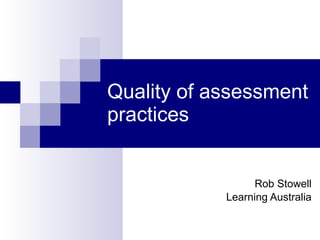
Appendix 4 Quality Of Assessment Practices Presentation
- 1. Quality of assessment practices Rob Stowell Learning Australia
- 7. Changing emphasis in assessment Now Past Future Outcomes focused Learner centered Producing learners Competence Authenticity Developing capacity to make judgements Learning and assessment skills beyond formal training Knowledge focused Teacher centered Testing students Educational measurement
- 8. Activity - Complete the cartoon
- 14. Performance range in control groups Range of typical performance enhancements in ‘assessment for learning’ groups Performance range in Assessment for Learning groups Source: Black and Wiliam (1998) Average effect size: 25% shift in performance compared to control groups after 2.5 years, and a reduced ‘spread’ in the performance range. Low Low High High Evidence – Black and Wiliam
- 17. Five key strategies … Sharing Learning Expectations Questioning Clarifying and sharing learning intentions and criteria for success Engineering effective discussion, questions, and learning tasks Feedback Moving learners forward with feedback Self Assessment Activating learners as the owners of their own learning Peer Assessment Activating learners as instructional resources for one another
- 19. Find x . 3 cms 4 cms x
- 21. So, how do you do it? The procedure is actually quite simple. First you arrange things into different groups. Of course, one pile may be sufficient, depending on how much there is to do. If you have to go somewhere else due to lack of facilities, that is the next step. Otherwise you are pretty well set. It is important not to overdo things – that is, it is better to do too few things at once than too many. In the short run, this might not seem important, but complications can easily arise. A mistake can be expensive as well. After the procedure is completed, one arranges the materials into different groups again. Then they can be put into their appropriate places. Eventually they’ll be used once more and the whole cycle will have to be repeated. However, that is a part of life. So, how do you do it?
- 25. Activity – Rate VET Practitioner skills Powerful in promoting quality learning and assessment Difficult to implement Easy to implement Not so powerful in promoting quality learning and assessment 1 2 3 4
- 27. Further information Publications: Inside the Black Box, Raising Standards Through Classroom Assessment (Paul Black and Dylan Wiliam, 1998) Straitjacket or springboard for sustainable learning? The implications of formative assessment practices in vocational learning cultures in The Curriculum Journal, Volume 19, No. 2 June, 2008 Quality Assurance Agency for Higher Education, Integrative Assessment : Balancing assessment of and assessment for learning, QAA 2007 Formative Assessment in Action: Weaving the Elements Together (Shirley Clarke, 2005) Websites: www.aaia.org.uk www.assessmentfutures.com www.qca.org.uk www.slamnet.org.uk http://arg.educ.cam.ac.uk http://cms.curriculum.edu.au/assessment/ http://www.assessment-reform-group.org/ http://www.tki.org.nz/r/assessment/atol_online/tutorials_e.php
Notes de l'éditeur
- Finally, Black and Wiliam concluded that no other single improvement initiative improved performance levels to the extent that formative assessment did. Black and Wiliam’s review of at least 20 studies on classroom assessment showed that significant, and often substantial, quantifiable learning gains were achieved in the classrooms conducting formative assessment experiments. There is a long known effect of drift as learners get older, especially among those learners at the bottom end of the performance range. Evidence shows a tendency for learners at the bottom end of the range to ‘catch up’ due to the increased performance assessment for learning stimulates. This slide shows the range of improvement indicated in the research. It reflects learners of all learning abilities. The improvement ranges from 15 to 30 percent, with differential effects in post-primary of around 2 full grades at GCSE after 2-3 years. These figures have since been underpinned by subsequent research in UK schools like the Kings-Medway-Oxfordshire formative assessment project (1999 onwards) and The Gillingham Partnership’s formative assessment project (2000-2002).
- Finally, here’s a list of publications and websites where you can find more information about Assessment for Learning practice in classrooms. (Pass out Handout 1) Details on these same publications appear on this handout.
